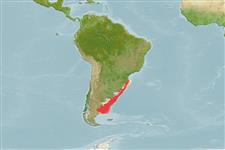Elasmobranchi (squali e razze) (sharks and rays) >
Carcharhiniformes (Ground sharks) >
Triakidae (Houndsharks) > Triakinae
Etymology: Mustelus: Latin for weasel, an ancient name for sharks, possibly referring to the pointed snouts, swift movements and/or rapacious feeding behavior of smaller predatory sharks [strictly not tautonymous with Squalus mustelus Linnaeus 1758 since type was designated by the ICZN] (See ETYFish); schmitti: In honor of American biologist Waldo L. Schmitt (1887-1977), curator of marine invertebrates at the U.S. National Museum, who collected holotype (See ETYFish).
Eponymy: Dr Waldo LaSalle Schmitt (1887–1977) was an expert on crustaceans who worked at the Smithsonian (1915–1957). [...] (Ref. 128868), visit book page.
Environment: milieu / climate zone / distribuzione batimetrica / distribution range
Ecologia
marino demersale; oceanodromo (Ref. 51243); distribuzione batimetrica 60 - 195 m (Ref. 27770). Subtropical; 28°S - 45°S, 66°W - 46°W (Ref. 244)
Southwest Atlantic: southern Brazil to northern Argentina.
Length at first maturity / Size / Peso / Age
Maturità: Lm 58.3, range 55 - 62 cm
Max length : 92.0 cm TL maschio/sesso non determinato; (Ref. 57911); common length : 60.0 cm TL maschio/sesso non determinato; (Ref. 6077)
Found on the continental shelf. Feeds on crabs and probably other crustaceans, and presumably small fishes. Ovoviviparous (aplacental) with 2 to 7 pups per litter. Size at birth 26 cm. Utilized for human consumption.
Ovoviviparous, embryos feed solely on yolk (Ref. 50449). Distinct pairing with embrace (Ref. 205).
Compagno, L.J.V., 1984. FAO Species Catalogue. Vol. 4. Sharks of the world. An annotated and illustrated catalogue of shark species known to date. Part 2 - Carcharhiniformes. FAO Fish. Synop. 125(4/2):251-655. Rome: FAO. (Ref. 244)
IUCN Red List Status (Ref. 130435: Version 2025-1)
Threat to humans
Harmless
Human uses
Pesca: elevato interesse commerciale
Strumenti
Special reports
Download XML
Fonti Internet
Estimates based on models
Preferred temperature (Fonte Biblio.
123201): 4.5 - 14.2, mean 7.9 °C (based on 118 cells).
Phylogenetic diversity index (Fonte Biblio.
82804): PD
50 = 0.5000 [Uniqueness, from 0.5 = low to 2.0 = high].
Bayesian length-weight: a=0.00257 (0.00166 - 0.00398), b=3.10 (2.97 - 3.23), in cm total length, based on LWR estimates for this species & Genus-body shape (Ref.
93245).
Trophic level (Fonte Biblio.
69278): 3.6 ±0.3 se; based on diet studies.
Generation time: 18.0 ( na - na) years. Estimated as median ln(3)/K based on 2
growth studies.
Resilienza (Fonte Biblio.
120179): Molto basso, tempo minimo di raddoppiamento della popolazione più di 14 anni (Fec=2-3).
Fishing Vulnerability (Ref.
59153): High vulnerability (58 of 100).
🛈
Climate Vulnerability (Ref.
125649): Very high vulnerability (87 of 100).
🛈
Nutrients (Ref.
124155): Calcium = 22.3 [6.0, 110.4] mg/100g; Iron = 0.517 [0.160, 1.927] mg/100g; Protein = 21.7 [19.4, 24.0] %; Omega3 = 0.143 [0.059, 0.338] g/100g; Selenium = 38.2 [11.0, 135.0] μg/100g; VitaminA = 7.36 [2.55, 20.30] μg/100g; Zinc = 0.638 [0.282, 1.271] mg/100g (wet weight);
